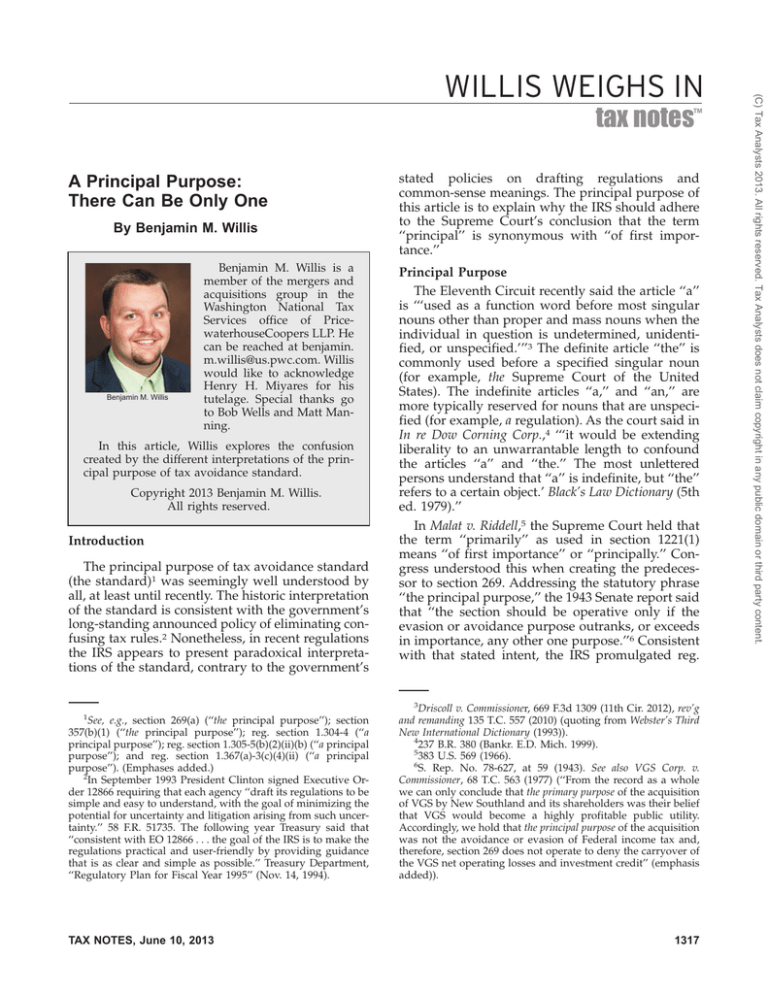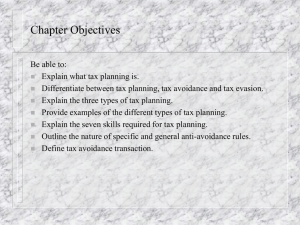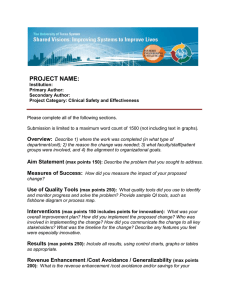
tax notes™
A Principal Purpose:
There Can Be Only One
By Benjamin M. Willis
Benjamin M. Willis
Benjamin M. Willis is a
member of the mergers and
acquisitions group in the
Washington National Tax
Services office of PricewaterhouseCoopers LLP. He
can be reached at benjamin.
m.willis@us.pwc.com. Willis
would like to acknowledge
Henry H. Miyares for his
tutelage. Special thanks go
to Bob Wells and Matt Manning.
In this article, Willis explores the confusion
created by the different interpretations of the principal purpose of tax avoidance standard.
Copyright 2013 Benjamin M. Willis.
All rights reserved.
Introduction
The principal purpose of tax avoidance standard
(the standard)1 was seemingly well understood by
all, at least until recently. The historic interpretation
of the standard is consistent with the government’s
long-standing announced policy of eliminating confusing tax rules.2 Nonetheless, in recent regulations
the IRS appears to present paradoxical interpretations of the standard, contrary to the government’s
1
See, e.g., section 269(a) (‘‘the principal purpose’’); section
357(b)(1) (‘‘the principal purpose’’); reg. section 1.304-4 (‘‘a
principal purpose’’); reg. section 1.305-5(b)(2)(ii)(b) (‘‘a principal
purpose’’); and reg. section 1.367(a)-3(c)(4)(ii) (‘‘a principal
purpose’’). (Emphases added.)
2
In September 1993 President Clinton signed Executive Order 12866 requiring that each agency ‘‘draft its regulations to be
simple and easy to understand, with the goal of minimizing the
potential for uncertainty and litigation arising from such uncertainty.’’ 58 F.R. 51735. The following year Treasury said that
‘‘consistent with EO 12866 . . . the goal of the IRS is to make the
regulations practical and user-friendly by providing guidance
that is as clear and simple as possible.’’ Treasury Department,
‘‘Regulatory Plan for Fiscal Year 1995’’ (Nov. 14, 1994).
TAX NOTES, June 10, 2013
stated policies on drafting regulations and
common-sense meanings. The principal purpose of
this article is to explain why the IRS should adhere
to the Supreme Court’s conclusion that the term
‘‘principal’’ is synonymous with ‘‘of first importance.’’
Principal Purpose
The Eleventh Circuit recently said the article ‘‘a’’
is ‘‘‘used as a function word before most singular
nouns other than proper and mass nouns when the
individual in question is undetermined, unidentified, or unspecified.’’’3 The definite article ‘‘the’’ is
commonly used before a specified singular noun
(for example, the Supreme Court of the United
States). The indefinite articles ‘‘a,’’ and ‘‘an,’’ are
more typically reserved for nouns that are unspecified (for example, a regulation). As the court said in
In re Dow Corning Corp.,4 ‘‘‘it would be extending
liberality to an unwarrantable length to confound
the articles ‘‘a’’ and ‘‘the.’’ The most unlettered
persons understand that ‘‘a’’ is indefinite, but ‘‘the’’
refers to a certain object.’ Black’s Law Dictionary (5th
ed. 1979).’’
In Malat v. Riddell,5 the Supreme Court held that
the term ‘‘primarily’’ as used in section 1221(1)
means ‘‘of first importance’’ or ‘‘principally.’’ Congress understood this when creating the predecessor to section 269. Addressing the statutory phrase
‘‘the principal purpose,’’ the 1943 Senate report said
that ‘‘the section should be operative only if the
evasion or avoidance purpose outranks, or exceeds
in importance, any other one purpose.’’6 Consistent
with that stated intent, the IRS promulgated reg.
3
Driscoll v. Commissioner, 669 F.3d 1309 (11th Cir. 2012), rev’g
and remanding 135 T.C. 557 (2010) (quoting from Webster’s Third
New International Dictionary (1993)).
4
237 B.R. 380 (Bankr. E.D. Mich. 1999).
5
383 U.S. 569 (1966).
6
S. Rep. No. 78-627, at 59 (1943). See also VGS Corp. v.
Commissioner, 68 T.C. 563 (1977) (‘‘From the record as a whole
we can only conclude that the primary purpose of the acquisition
of VGS by New Southland and its shareholders was their belief
that VGS would become a highly profitable public utility.
Accordingly, we hold that the principal purpose of the acquisition
was not the avoidance or evasion of Federal income tax and,
therefore, section 269 does not operate to deny the carryover of
the VGS net operating losses and investment credit’’ (emphasis
added)).
1317
(C) Tax Analysts 2013. All rights reserved. Tax Analysts does not claim copyright in any public domain or third party content.
WILLIS WEIGHS IN
COMMENTARY / WILLIS WEIGHS IN
The Supreme Court requires that when applying
principles of statutory construction, it should first
be determined whether the language at issue has a
plain and unambiguous meaning.8 The plain meanings of ‘‘a,’’ ‘‘the,’’ and ‘‘principal’’ should be clear.
So, can an indefinite article modify the commonsense meaning of principal purpose? Historically,
the courts have agreed that the answer is no;
however, some recent cases appear to have allowed
the indefinite article ‘‘a’’ to redefine the standard.
The IRS has similarly attempted to change the
standard in recent regulations despite Riddell and
many other decisions.
There Can Be Only One Principal Purpose
Several cases addressing the meaning of the
phrase ‘‘a principal purpose’’ indicate that it is
synonymous with ‘‘the principal purpose.’’ In more
recent legislation, Congress appears to have used
‘‘one of its’’ interchangeably with ‘‘a’’ in drafting
antiavoidance rules under which the principal purpose standard can apply to a series of transactions.9
Because the word ‘‘principal’’ allows only for a
singular item, ‘‘one of its’’ principal purposes must
be read in its plural form (that is, transactions
pursuant to a plan that each have a principal
purpose and collectively have principal pur-
7
See Bobsee Corp. v. United States, 411 F.2d 231 (5th Cir. 1969)
(stating with respect to section 269 that ‘‘our Green Light
decision heeded the policy and the actual language of the
section rather than the abortive attempt at definition in the
Senate committee report. As we view the operation of the
statute, there are only two relevant classes of purposes: taxavoidance and non-tax-avoidance; the statute applies only if the
former class exceeds the latter’’).
8
See Barnhart v. Sigmon Coal Co. Inc., 534 U.S. 438 (2002), citing
Robinson v. Shell Oil Co., 519 U.S. 337 (1997), citing United States
v. Ron Pair Enterprises Inc., 489 U.S. 235 (1998). See also Connecticut National Bank v. Germain, 503 U.S. 249, 253-254 (1992) (‘‘We
have stated time and again that courts must presume that a
legislature says in a statute what it means and means in a statute
what it says there’’).
9
See, e.g., section 954(h)(7), which states that ‘‘there shall be
disregarded any item of income, gain, loss, or deduction with
respect to any transaction or series of transactions one of the
principal purposes of which is qualifying income or gain for the
exclusion under this section, including any transaction or series
of transactions a principal purpose of which is the acceleration or
deferral of any item in order to claim the benefits of such
exclusion through the application of this subsection’’ (emphasis
added); see also section 877(f), which provides as ‘‘one of its
principal purposes the avoidance of taxes’’ and section
306(b)(4), which requires in certain instances that a transaction is
‘‘not in pursuance of a plan having as one of its principal
purposes the avoidance of Federal income tax.’’
1318
poses).10 Thus, ‘‘one of its’’ and ‘‘a’’ should be
synonymous when used in the context of the standard in a single transaction.
In Dittler Bros. Inc. v. Commissioner,11 the Tax
Court interpreted the former section 367 rule requiring that the parties to an expatriating transfer of
property establish to the IRS that the exchange was
not ‘‘in pursuance of a plan having as one of its
principal purposes the avoidance of Federal income
taxes’’:
Although we have never interpreted the term
principal purpose within the context of section
367, nonetheless, we have interpreted the
meaning of principal purpose in a somewhat
analogous provision under section 269. . . . In
contrast to section 269, section 367 speaks in
terms of a plan having as one of its principal
purposes the avoidance of Federal income
taxes. . . . We believe that the term ‘‘principal
purpose’’ should be construed in accordance
with its ordinary meaning. Such a rule of
statutory construction has been endorsed by
the Supreme Court. Malat v. Riddell, 383 U.S.
569, 571 (1966). Webster’s New Collegiate Dictionary defines ‘‘principal’’ as ‘‘first in rank,
authority, importance, or degree.’’ Thus, the
proper inquiry hereunder is whether the exchange of manufacturing know-how was in
pursuance of a plan having as one of its
‘‘first-in-importance’’ purposes the avoidance
of Federal income taxes.12 [Emphasis added.]
Therefore, reference to ‘‘one of its principal purposes’’ still requires the tested transaction to have a
primary purpose of tax avoidance. The Fifth Circuit
affirmed the Tax Court’s holding in Dittler.13
Further, in Pitcher v. Commissioner,14 the Tax
Court said:
As we held in Dittler . . . the proper test for
whether tax avoidance was a principal purpose
10
Supra note 7.
72 T.C. 896 (1979).
12
See also Hershey Food Corp. v. Commissioner, 76 T.C. 312
(1981); Kaiser Aluminum & Chemical Corp. v. Commissioner, 76 T.C.
325 (1981); and Girli & Co. Inc. v. Commissioner, 668 F.2d 691 (2d
Cir. 1982). For a thorough discussion of Dittler and the historic
uncertainty of the use of the phrase ‘‘principal purpose’’ in
section 367, see E.C. Lashbrooke Jr., ‘‘Recapture of Past Foreign
Branch Losses on Transfer of Branch Assets to a Foreign
Corporation,’’ 4 Nw. J. Int’l L. & Bus. 359 (1982) (‘‘Congress has
not provided any statutory guidance in the Code on what
constitutes a plan having the avoidance of federal income taxes
as one of its principal purposes, and the IRS and the courts have
provided disparate guidelines’’). See also Steven W. McLeighton,
‘‘Complex Rules Burden Outbound Transfers of Tangibles and
Intangibles,’’ The Tax Adviser (1997).
13
642 F.2d 1211 (5th Cir. 1981).
14
84 T.C. 85 (1985).
11
TAX NOTES, June 10, 2013
(C) Tax Analysts 2013. All rights reserved. Tax Analysts does not claim copyright in any public domain or third party content.
section 1.269-3(a), which says: ‘‘If the purpose to
evade or avoid Federal income tax exceeds in
importance any other purpose, it is the principal
purpose.’’7
COMMENTARY / WILLIS WEIGHS IN
The prior law provisions in section 367(a)
applied only to transfers pursuant to ‘‘a plan
having as one of its principal purposes the
avoidance of Federal income taxes.’’ Interpreting this provision in Dittler Bros., the Tax Court
required that a tax avoidance purpose for a
transfer be greater in importance than any
business purpose before section 367(a) was
applied to prevent a tax-free outbound transfer of property.16
In Furstenberg v. Commissioner,17 the Tax Court
interpreted ‘‘one of its principal purposes’’ in section 877,18 which can affect the taxation of expatriated citizens. Citing Dittler, the court said, ‘‘We
15
The Pitcher court explained that in the section 351 transaction ‘‘YPI clearly needed capital in order to continue profitable
operations, and the management of YPI decided that a public
offering was the optimal approach. A foreign offering avoided
the time and money involved with the SEC registration needed
for a domestic offering. Management chose Canada due to prior
dealings with Canadian investors, geographic proximity, and a
favorable market outlook.’’
16
Joint Committee on Taxation, ‘‘General Explanation of the
Revenue Provisions of the Deficit Reduction Act of 1984,’’
JCS-41-84 (Dec. 31, 1984).
17
83 T.C. 755 (1984).
18
For a thorough discussion of this case and the historic
uncertainty of the use of ‘‘principal purpose’’ in section 877, see
Emmanuelle Lee, Comment, ‘‘Will the Reunification of U.S.
Citizenship Still Be Worth Some Tax Savings — An Analysis of
the Recent Reform on the Taxation of Expatriates,’’ 37 Santa
Clara L. Rev. 1063 (1997). See also LTR 200403047 (concluding
‘‘that A will not be treated under section 877(a)(2) as having the
believe that the term ‘principal purpose’ should be
construed in accordance with its ordinary meaning.
Such a rule of statutory construction has been
endorsed by the Supreme Court. Malat v. Riddell,
383 U.S. 569, 571 (1966).’’
The Joint Committee on Taxation has cited both
Dittler and Furstenberg for the proposition that the
IRS will have more difficulty in showing tax avoidance was one of a transaction’s principal purposes
under a ‘‘first-in-importance’’ standard.19 Moreover,
the courts continue to rely on the Riddell standard.
In Commissioner v. Soliman,20 the Supreme Court
again explained that ‘‘both the commonsense and
dictionary meanings of ‘principal’ demonstrate that
this constitutes the most important or significant.’’21
In the section 1248 context, the Tax Court has
looked to the well-recognized standard applied in
sections 269, 367, and 1221, as discussed above, for
defining the word ‘‘principally.’’ Section 1248(e)
applies section 1248(a) to some situations when a
domestic corporation was ‘‘formed or availed of
principally for the holding, directly or indirectly, of
stock of one or more foreign corporations.’’ In
explaining its conclusion, the Tax Court in Teller v.
Commissioner22 stated:
While no cases have specifically addressed the
meaning to be afforded to the term ‘‘principally’’ within the context of section 1248, that
term has been defined in other contexts. The
phrase ‘‘principal purpose’’ is used in section
269 and explained in section 1.269-3(a), Income Tax Regs., as being a purpose that exceeds, in importance, any other purpose.
Additionally, the Supreme Court has defined
avoidance of U.S. taxes as a principal purpose for her expatriation because the information submitted clearly establishes the
lack of a principal purpose to avoid taxes under subtitle A or B
of the Code’’ (emphasis added)).
19
See also JCT, ‘‘Issues Presented by Proposals to Modify the
Tax Treatment of Expatriation,’’ JCS-17-95, Appendix G (June 1,
1995). ‘‘In Furstenberg v. Comm’r, 83 T.C. 755 (1984), the Tax
Court made it easier for the taxpayer to establish lack of tax
avoidance purpose (and, therefore, more difficult for the IRS to
establish tax motivation). In 1975, Cecil von Furstenberg saved
over $5 million in U.S. taxes by relinquishing her U.S. citizenship. In a 1984 decision, the Tax Court, adopting the principal
purpose of tax avoidance standard set forth in Dittler Bros., Inc.
v. Commissioner, 72 T.C. 896 (1979), found that Ms. Furstenberg
was not subject to U.S. tax under section 877 because tax
avoidance was not one of her ‘first-in-importance’ purposes’’).
20
506 U.S. 168 (1993).
21
The Court was interpreting the reference to ‘‘principal
place of business’’ in section 280A(c)(1)(A). Citing Riddell, the
Court said it ‘‘looks to words’ ‘ordinary, everyday senses’ in
interpreting a revenue statute’s meaning.’’ Id.
22
T.C. Memo. 1992-402.
(Footnote continued in next column.)
TAX NOTES, June 10, 2013
1319
(C) Tax Analysts 2013. All rights reserved. Tax Analysts does not claim copyright in any public domain or third party content.
is not, as respondent urges, whether a taxavoidance purpose ‘‘figures prominently as a
reason for the plan,’’ or whether business
reasons are ‘‘so overwhelming as to make tax
avoidance a negligible concern,’’ but rather
whether the transaction had ‘‘as one of its
‘first-in-importance’ purposes the avoidance
of Federal income taxes.’’ [Emphasis added.]
Despite the choice of words, ‘‘one of its principal
purposes’’ still requires the tested transaction to
have a single primary purpose of tax avoidance,
which is why the Tax Court stated ‘‘we think
respondent is grasping at straws in an effort to
persuade us to hold that tax avoidance was one of
the principal purposes of the exchange involved
herein.’’15
Following the holding in Dittler, Congress removed the principal purpose of tax avoidance standard from section 367 and adopted statutory rules
that provided taxpayers greater certainty and more
objective standards (for example, the active trade or
business test). The 1984 blue book addressed the
Tax Court’s interpretation of principal purpose in
Dittler, stating:
COMMENTARY / WILLIS WEIGHS IN
The IRS has at times respected the Supreme
Court’s conclusion in Riddell when interpreting ‘‘a
principal purpose.’’ For example, when contemplating the design of section 954 regulations, the IRS
opted to use ‘‘a significant purpose’’ instead of ‘‘a
principal purpose.’’ In making that decision, the IRS
said: ‘‘Thus, in line with the decision in [Riddell], a
distinction is drawn between a significant purpose
and a principal purpose (or purpose of first importance). The former is clearly a lesser standard’’24
(emphasis added).
More Than One Principal Purpose?
In apparent contrast to the decisions discussed
above is the Seventh Circuit’s interpretation of ‘‘a
principal purpose’’ under 29 U.S.C. section 1392(c)
in Santa Fe Pacific Corp. v. Central States, Southeast
and Southwest Areas Pension Fund,25 a labor law case
governed by ERISA rules:
The imposition of withdrawal liability in a sale
of business situation requires only that a principal purpose of the sale be to escape withdrawal liability. It needn’t be the only purpose;
it need only have been one of the factors that
weighed heavily in the seller’s thinking. We can
find no decisions discussing situations in
which there is more than one principal (major,
weighty, salient, important) purpose, but we
would be doing violence to the language and
the purpose of the statute if we read ‘‘a principal’’ as ‘‘the principal.’’ [Emphasis added.]
23
See also Jefferson v. Commissioner, 50 T.C. 963, 968 (1968)
(citing Riddell for the conclusion that individuals may take
losses for transactions entered into ‘‘primarily’’ for profit under
section 165 because of its ‘‘ordinary and everyday meaning, viz,
‘of first importance’’’).
24
Notice of Proposed Rulemaking (Mar. 8, 1972). But see 53
F.R. 27489 (providing, in direct conflict with the U.S. Supreme
Court’s decision in Riddell that ‘‘a principal purpose need not be
the purpose of first importance’’).
25
22 F.3d 725 (7th Cir. 1994).
Therefore, according to the Seventh Circuit, taxpayers must demonstrate in the context of 29 U.S.C.
section 1392(c) that avoidance of a withdrawal
liability was not a major, salient, or important factor
for undertaking the transaction. The IRS has attempted to rely on the Santa Fe standard when
interpreting ‘‘a principal purpose’’ as used in a tax
regulation,26 contrary to its prior interpretation,
which was based on a Supreme Court decision.27
In Teamsters Joint Council v. Empire Beef Co.,28 on
remand from the Fourth Circuit, the district court
similarly examined ‘‘a principal purpose’’ under 29
U.S.C. section 1392. It observed:
Section 1392(c) requires only that ‘‘a principal
purpose’’ (as opposed to ‘‘the principal purpose’’) of the transaction be to evade or avoid
withdrawal liability. Plaintiffs read the word
‘‘principal’’ out of the statute altogether. ‘‘The
clear import of ‘a principal’ is to let the employer off the hook even if one of his purposes
was to beat withdrawal liability, provided however that it was a minor, subordinate purpose.’’ Santa Fe Pac. Corp. v. Cent. States Se. &
Sw. Areas Pension Fund, 22 F.3d 725, 727 (7th
Cir. 1994) (emphasis added). . . . Section
1392(c) does not apply unless evading withdrawal liability was ‘‘one of the factors that
weighed heavily in the [employer’s] thinking.’’
Id. [Emphasis added.]
The court went on to determine that ‘‘a principal
purpose’’ of the agreement in question was not to
avoid the withdrawal liability but was ‘‘merely a
collateral purpose.’’29
26
See also LTR 9509035, relying on Santa Fe, in which the IRS
states:
Section 1.148-10(e) provides that if an issuer enters into a
transaction for a principal purpose of obtaining a material
financial advantage based on the difference between
tax-exempt and taxable interest rates in a manner that is
inconsistent with the purposes of section 148. . . . Although the City represents that it prepaid the City
Liability and issued the BANs because of the savings
available from the prepayment of the City Liability, the
issue is not whether the City had compelling reasons independent of the opportunity to earn arbitrage; it is whether the
opportunity to earn arbitrage is one of the principal purposes of
issuing the Proposed Bonds . . . [i.e.,] one of the factors
that weighed heavily in the seller’s thinking. [Emphasis
added.]
27
Supra note 24.
28
No. 3:08-cv-340 (E.D. Va. 2011).
29
See also City of Columbus, Ohio v. Commissioner, 106 T.C. 325
(1996), vacated and remanded on other grounds, 112 F.3d 1201 (D.C.
Cir. 1997), in which the Tax Court relied on Santa Fe in
examining reg. section 1.148-1(b). The regulation provides that
investment-type property includes ‘‘a prepayment for property
or services . . . if a principal purpose for prepaying is to receive
an investment return from the time the prepayment is made
(Footnote continued on next page.)
1320
TAX NOTES, June 10, 2013
(C) Tax Analysts 2013. All rights reserved. Tax Analysts does not claim copyright in any public domain or third party content.
the term ‘‘primarily’’ in connection with section 1221 as ‘‘principally’’ or ‘‘of first importance.’’ Malat v. Riddell, 383 U.S. 569 (1966).
Although the term ‘‘principally’’ is used in
Malat v. Riddell, supra, in a manner that is
correlative or reciprocal to its use in section
1248, it may be considered as an equivalency
in this setting. On numerous occasions we
have interpreted statutory language by reference to the meaning of a word in its ordinary
everyday sense. We accord the everyday
meaning to the term ‘‘principally’’ as being of
first importance. One may reasonably deduce
from other usages of the term ‘‘principal’’ that
it is not equivalent to the term ‘‘substantial.’’23
COMMENTARY / WILLIS WEIGHS IN
until the time payment otherwise would be made.’’ One of the
city’s principal purposes for the 1994 transaction was to ‘‘receive
an investment return,’’ and there was no question that the city’s
purpose in prepaying the city obligation was to profit. However,
the Tax Court said:
The fact that [the city] would profit from the discount if
the interest on the proposed bonds were taxable does not
negate the fact that such profit would be greater if such
interest was exempt from tax under section 103(a). Nor
does the fact that the issuance of taxable bonds would
also be advantageous turn the purpose of the proposed
issue on a nontaxable basis from a principal to a subsidiary purpose. Such a view would emasculate the arbitrage
restrictions of section 148 whenever a financial advantage
of a bond issue could be obtained whether the interest on
the bonds was taxable or nontaxable. In this connection, we
think it significant that the regulation speaks in terms of ‘‘a’’
and not ‘‘the’’ principal purpose. Santa Fe Pac. Corp. v. Cent.
States, Se. & Sw. Areas Pension Fund, 22 F.3d 725, 729-30
(7th Cir. 1994). [Emphasis added.]
TAX NOTES, June 10, 2013
1392(c) when it carries out a business transaction whose most important goal is getting
around or preventing withdrawal liability.’’
[Emphasis added.]
Conclusion
The Supreme Court’s holding in Riddell suggests
that any standard using ‘‘principal purpose’’ is met
only when the purpose to evade tax exceeds any
other purpose. Relying on Riddell, courts have held
in the section 269, 367, 1248, and 877 contexts that a
principal purpose of tax avoidance standard is
satisfied only when the avoidance of tax outranks
any other purpose. Conversely, there are 29 U.S.C.
section 1392(c) ERISA authorities that support the
proposition that a principal purpose need only have
been one of the factors that weighed heavily in the
taxpayer’s thinking. In the end, we are left with the
opposing logic of Dittler and Santa Fe — the former
being based on the plain meaning of the word
‘‘principal’’ while the latter is based on the meaning
of ‘‘a,’’ an indefinite article that effectively means
nothing.
I believe a plain and common-sense reading of
the principal purpose of the tax avoidance standard
is clear and requires no further scrutiny regardless
of the article preceding it. The courts weighed in
and there can be only one principal purpose for any
given transaction examined under the standard.
Consistent with its stated policy, Treasury should
recognize that sound administration requires clear,
understandable regulations. If a principal purpose
of tax avoidance standard does not suffice, the IRS
should use a different standard, for example ‘‘a
substantial purpose,’’30 if that standard is consistent
with the congressional intent reflected in the statute. The application of either standard in tax penalty provisions is generally construed in favor of
taxpayers, as we’ll soon discuss.
30
See section 7701(o)(1)(B) (requiring ‘‘a substantial purpose’’
other than tax in some instances).
1321
(C) Tax Analysts 2013. All rights reserved. Tax Analysts does not claim copyright in any public domain or third party content.
Santa Fe and Teamsters are not tax cases and do
not interpret provisions of the IRC or any tax
regulations. Further, the logic of their conclusions
has been rejected in favor of the reasoning found in
Riddell. In Sun Capital Partners v. New England Teamsters, No. 1:10-cv-10921-DPW, 2012 WL 5197117 (D.
Mass. Oct. 18, 2012), the federal district court in
Massachusetts explained, with respect to 29 U.S.C
section 1392(c), that:
The adjective ‘‘principal’’ means ‘‘most important, consequential, or influential.’’ Webster’s
Third New Int’l Dictionary 1802 (1986). The
noun ‘‘purpose’’ means ‘‘an object, effect, or
result aimed at, intended, or attained.’’ Id. at
1847. The noun ‘‘transaction’’ means ‘‘an act,
process, or instance of transacting,’’ and the
verb ‘‘transact’’ means ‘‘to prosecute negotiations’’ or ‘‘carry on business.’’ Id. at 2425. The
verb ‘‘evade’’ means ‘‘to manage to avoid the
performance of (an obligation)’’ or ‘‘to get
around (an intellectual obstacle).’’ Id. at 786.
The verb ‘‘avoid’’ means ‘‘to keep away from’’
or ‘‘to prevent the occurrence or effectiveness
of.’’ Id. at 151. Thus, under the plain meaning
of the text, a person or entity violates section





